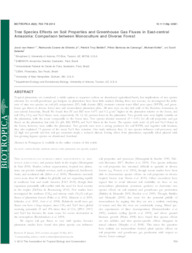Tree species effects on soil properties and greenhouse gas fluxes in East-central Amazonia: comparison between Monoculture and Diverse Forest.
Tree species effects on soil properties and greenhouse gas fluxes in East-central Amazonia: comparison between Monoculture and Diverse Forest.
Author(s): VAN HAREN, J.; OLIVEIRA JUNIOR, R. C. de; BELDINI, P. T.; CAMARGO, P. B.; KELLER, M.; SALESKA, S.
Summary: Tropical plantations are considered a viable option to sequester carbon on abandoned agricultural lands, but implications of tree species selection for overall greenhouse gas budgets on plantations have been little studied. During three wet seasons, we investigated the influence of nine tree species on soil pH, temperature (ST), bulk density (BD), moisture content water filled pore space (WFPS), and greenhouse gas fluxes in diverse forest sites and monoculture plantation plots. All sites were on clay-rich soils of the Barreiras formation, in east-central Amazônia, Brazil. We found that ST and BD were 0.6°C and 0.2 g/cm3 higher in the plantation relative to the forest, and soil CH4, CO,2 and N2O fluxes were, respectively, 38, 12, 62, percent lower in the plantation. Tree growth rates were highly variable on the plantation, with the mean comparable to the forest sites. Tree species identity mattered (P < 0.01) for all soil properties and gas fluxes on the plantation, but only for pH, BD, WFPS, and N2O fluxes in the forest. The species rank order of pH and N2O fluxes in the forest, however, were unlike the plantation. Tree growth rates were a strong predictor for soil WFPS, and together with location, they also explained 75 percent of the mean N2O flux variation. Our study indicates that: (1) tree species influence soil processes; and (2) high tree growth and low soil gas emissions imply a reduced climate forcing effect from plantations, especially when planted with fast-growing legume species on abandoned farmland.
Publication year: 2013
Types of publication: Journal article
Unit: Embrapa Territorial
Observation
Some of Embrapa's publications are published as ePub files. To read them, use or download one of the following free software options to your computer or mobile device. Android: Google Play Books; IOS: iBooks; Windows and Linux: Calibre.
Access other publications
Access the Agricultural Research Database (BDPA) to consult Embrapa's full library collection and records.
Visit Embrapa Bookstore to purchase books and other publications sold by Embrapa.

